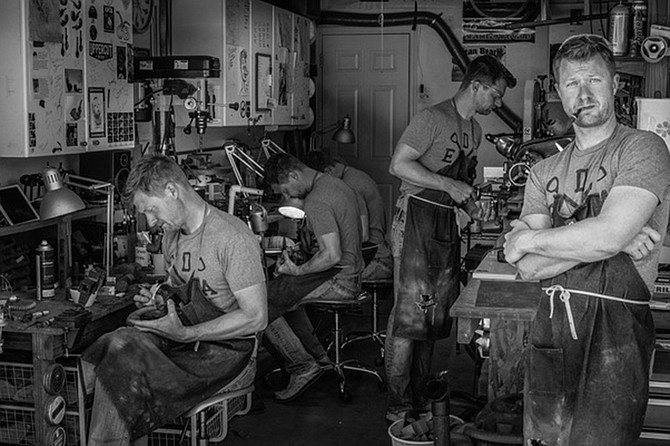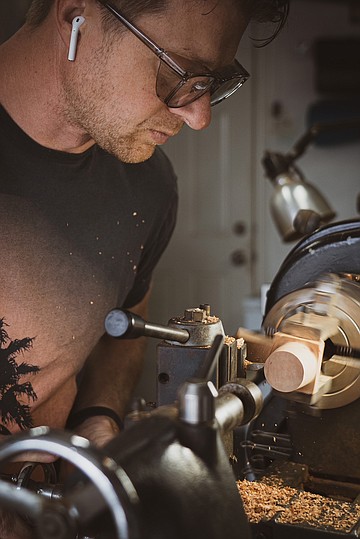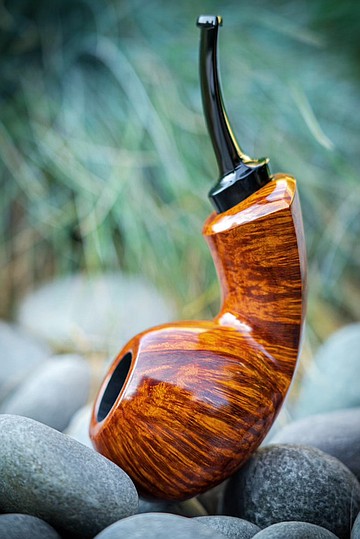 Facebook
Facebook
 X
X
 Instagram
Instagram
 TikTok
TikTok
 Youtube
Youtube

Briar boss
The dwindling remnants of San Diego’s coastal glow are fading into a mild Autumn dusk as I arrive for my meeting with master pipemaker Jeff Gracik. I find him in the spot where the majority of his working hours are spent: the main finishing desk in his compact home shop, a perch that is within arms reach of many of his tools, and only a few steps away from his other work stations. He is sitting, looking calmly focused, doing some sanding on a partially finished pipe as he waits for me. In front of him, at knee level, is his supply of Mediterranean briar blocks — hefty chunks of the hard burl that has proven to be the ideal wood for tobacco pipes. Gracik has handled each piece of briar in his possession, and knows what country it came from and who harvested it — now, each is labelled with permanent marker.

Gracik, the man behind J. Alan Pipes, may look a bit young for the appellation “master pipemaker.” But the people who know his work call him that. Gracik himself will say only that sure, he may be known to 50 or 60 far-flung people. He will, however, note that despite his relative youth, he has put a great deal of time and effort into his craft. “I got my 10,000 hours about 10 years ago,” he tells me. He is also quick to credit the encouragement, guidance, and supervision he’s received over the years from renowned artisans in both America and Denmark, a hub of modern pipe design since the middle of the last century. “I wouldn’t be here today if it weren’t for the generosity of those people.” he says.
Gracik got his start in the early 2000s while in graduate school in New Jersey. There, after switching from smoking the occasional cigar to puffing the occasional pipe, he developed an interest in making them, too. Soon, he was filling his academic notebooks with design sketches, and working on pipes in his spare time. He made his first one in 2003. But while he enjoyed his new hobby, he had no plans to let it take over his academic life or become his job. On the other hand, he was finding the work fulfilling in a way that was different from his academic pursuits. Eventually, the calling found him: by the next year, he found that people actually wanted to buy his pipes; then he started to build up a wait list. And the demand has kept growing: two weeks ago, Gracik stamped his 1800th pipe.
Reflecting on the path that brought him to where he is now, Gracik relates an amusing story about the first time that he took his wares to a pipe show. These would not have been as fine as what he’s producing today, but they must have demonstrated some promise, because they caught the eye of Tonni Nielsen, a well-known Danish pipemaker. “I had this little Harbor Freight five-dollar box that I had my five pipes in. I got some giggles from people, but Tonni was like (Gracik here puts on a convincing Danish accent) — ‘You know these are pretty good. You should come and work with me.’ He joined Nielson at a shop in Louisville, Kentucky soon after that, and spent just one (very full) day there soaking up all that he could from Nielsen.
That was long ago. These days, newer makers look to Gracik for guidance, and he’s provided it in numerous venues, including here in San Diego, at a twice-held “Pipe Makers Seminar by the Sea.”
About 40 minutes into our conversation, Gracik asks if I want to smoke a pipe. I have been hoping he would ask this, and I grab my own pipe pouch, but he encourages me to choose from a cabinet stocked mostly with pipes marked “Own” — as opposed to the numbered ones that go out to customers. I choose a medium-sized rendition of a shape that in the pipe world is called a “blowfish.” He carries it over to a buffing wheel and gives it a brief polish it before handing it to me. A nice craftsmanlike touch, I think to myself, as I note the svelte, gentle curve of its stem and its surprising lightness in the hand.

This touch, this craftsmanship, is the crux of the matter when it comes to the notion of “master.” In the field of individually made pipes, there is no “good enough.” Each one is an emblem of patience and careful attention, beginning with the raw material of the briar. Gracik will only use exceptionally good pieces. He is looking for attractive grain and the absence of blemishes, and blemishes are very common. And no matter how expert his inspection, he has to be prepared to find flaws after he has begun making a pipe. Next to his baskets of unworked briar is a separate one, filled with rejects that ceased to pass muster at some point in their transformation. Gracik tells me of the plans he has for some of these — some are, despite their flaws, good enough to be working pipes. Just not J. Alan pipes.
I mentioned above that Gracik spends most of his time at his finishing desk. This is because the first step of the process — the cutting out of the pipe’s rough shape on a band saw — is also the fastest. “The misperception by people on the outside is that the majority of time is spent on the shaping,” says Gracik, “and really that takes about ten minutes — especially when you know what you’re doing.” So what happens the rest of the time? There is the shaping of the tobacco chamber, something for which Gracik has had special drill bits created. There is the drilling of the airway. And then there is a great deal of finer shaping: sanding, sandblasting (for the pipes that want it), polishing, staining. Finally, at the end of that, there is, Gracik says simply, “The pleasure of having something that you’ve actually made.”


Briar boss
The dwindling remnants of San Diego’s coastal glow are fading into a mild Autumn dusk as I arrive for my meeting with master pipemaker Jeff Gracik. I find him in the spot where the majority of his working hours are spent: the main finishing desk in his compact home shop, a perch that is within arms reach of many of his tools, and only a few steps away from his other work stations. He is sitting, looking calmly focused, doing some sanding on a partially finished pipe as he waits for me. In front of him, at knee level, is his supply of Mediterranean briar blocks — hefty chunks of the hard burl that has proven to be the ideal wood for tobacco pipes. Gracik has handled each piece of briar in his possession, and knows what country it came from and who harvested it — now, each is labelled with permanent marker.

Gracik, the man behind J. Alan Pipes, may look a bit young for the appellation “master pipemaker.” But the people who know his work call him that. Gracik himself will say only that sure, he may be known to 50 or 60 far-flung people. He will, however, note that despite his relative youth, he has put a great deal of time and effort into his craft. “I got my 10,000 hours about 10 years ago,” he tells me. He is also quick to credit the encouragement, guidance, and supervision he’s received over the years from renowned artisans in both America and Denmark, a hub of modern pipe design since the middle of the last century. “I wouldn’t be here today if it weren’t for the generosity of those people.” he says.
Gracik got his start in the early 2000s while in graduate school in New Jersey. There, after switching from smoking the occasional cigar to puffing the occasional pipe, he developed an interest in making them, too. Soon, he was filling his academic notebooks with design sketches, and working on pipes in his spare time. He made his first one in 2003. But while he enjoyed his new hobby, he had no plans to let it take over his academic life or become his job. On the other hand, he was finding the work fulfilling in a way that was different from his academic pursuits. Eventually, the calling found him: by the next year, he found that people actually wanted to buy his pipes; then he started to build up a wait list. And the demand has kept growing: two weeks ago, Gracik stamped his 1800th pipe.
Reflecting on the path that brought him to where he is now, Gracik relates an amusing story about the first time that he took his wares to a pipe show. These would not have been as fine as what he’s producing today, but they must have demonstrated some promise, because they caught the eye of Tonni Nielsen, a well-known Danish pipemaker. “I had this little Harbor Freight five-dollar box that I had my five pipes in. I got some giggles from people, but Tonni was like (Gracik here puts on a convincing Danish accent) — ‘You know these are pretty good. You should come and work with me.’ He joined Nielson at a shop in Louisville, Kentucky soon after that, and spent just one (very full) day there soaking up all that he could from Nielsen.
That was long ago. These days, newer makers look to Gracik for guidance, and he’s provided it in numerous venues, including here in San Diego, at a twice-held “Pipe Makers Seminar by the Sea.”
About 40 minutes into our conversation, Gracik asks if I want to smoke a pipe. I have been hoping he would ask this, and I grab my own pipe pouch, but he encourages me to choose from a cabinet stocked mostly with pipes marked “Own” — as opposed to the numbered ones that go out to customers. I choose a medium-sized rendition of a shape that in the pipe world is called a “blowfish.” He carries it over to a buffing wheel and gives it a brief polish it before handing it to me. A nice craftsmanlike touch, I think to myself, as I note the svelte, gentle curve of its stem and its surprising lightness in the hand.

This touch, this craftsmanship, is the crux of the matter when it comes to the notion of “master.” In the field of individually made pipes, there is no “good enough.” Each one is an emblem of patience and careful attention, beginning with the raw material of the briar. Gracik will only use exceptionally good pieces. He is looking for attractive grain and the absence of blemishes, and blemishes are very common. And no matter how expert his inspection, he has to be prepared to find flaws after he has begun making a pipe. Next to his baskets of unworked briar is a separate one, filled with rejects that ceased to pass muster at some point in their transformation. Gracik tells me of the plans he has for some of these — some are, despite their flaws, good enough to be working pipes. Just not J. Alan pipes.
I mentioned above that Gracik spends most of his time at his finishing desk. This is because the first step of the process — the cutting out of the pipe’s rough shape on a band saw — is also the fastest. “The misperception by people on the outside is that the majority of time is spent on the shaping,” says Gracik, “and really that takes about ten minutes — especially when you know what you’re doing.” So what happens the rest of the time? There is the shaping of the tobacco chamber, something for which Gracik has had special drill bits created. There is the drilling of the airway. And then there is a great deal of finer shaping: sanding, sandblasting (for the pipes that want it), polishing, staining. Finally, at the end of that, there is, Gracik says simply, “The pleasure of having something that you’ve actually made.”
Comments